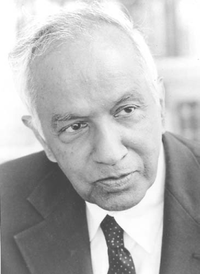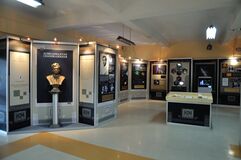سوبرامانيان تشاندراسخار
- In this Indian name, the name "سوبرامانيان" is a patronymic, not a family name, and the person should be referred to by the given name, "تشاندراسخار".
سوبرامانيان تشاندرسـِخـَر FRS (Subrahmanyan Chandrasekhar ؛ (النطق ؛ عاش 19 أكتوبر 1910 - 21 أغسطس 1995)[3] كان عالِماً في الفيزياء الفلكية أمريكي الجنسية هندي الأصل ولد في لاهور بالهند سافر إلى إنجلترا ليحصل على شهادة الفيزياء من جامعة كمبردج.
التسلسل الوظيفي
فى سنة 1936 ، أصبح باحثا مشاركا في مرصد يركس في أمريكا وجامعة شيكاغو وفي سنة 1944، أصبح أستاذا في هذة الجامعة.
كان فيزيائيا متخصصا بالهيدروديناميك لكنه أتجه الى الفيزياء الفلكية وخاصة التركيب الداخلى للنجوم وتطورها النهائي الى أقزام بيضاء أو نجوم نيوترونية.
اهتماماته
اشتهر اكثر ما اشتهر ببحوثه حول تحديد الكتلة القصوي (حد تشاندراسخر) فاكتشف أن النجم حين تتجاوز كتلته 1,4 مرة كتلة الشمس فستكون نهايته نجما نيوترونياً، أما إذا كانت كتلته أكبر فسينتهى إلى ثقب أسود وهذا الرقم (1,4) أطلق عليه حد تشاندراسخر.
لم يملك الشاب الهندي سوبرامانيان تشاندراسخار، مالاً ليحجز ولو مجرد سرير على السفينة التي حملته إلى بريطانيا. وصرف ذلك العالِم وقته جالساً على كرسي، ومنكباً على أوراق دوّن عليها معادلات فيزياء من وحي نظرية آينشتاين، وبعضاً من معادلات الفيزياء الكمومية. وقبيل وصوله إلى بريطانيا، توصّل إلى أن بعض النجوم الضخمة ينطفئ، ليتحوّل إلى «ثقب أسود»، لديه قوة جاذبيّة هائلة. وتعارض ذلك مع النظريات التي كانت سائدة في جامعة كامبردج، حيث عرض تشاندراسخر نظريته في العام 1935. ولم يلقّ سوى السخرية والازدراء. فسافر إلى أميركا. ودرّس في جامعاتها. واعتبر أبرز شارح لنظرية أينشتاين. وتدريجاً، تقبّل العلماء نظرية «الثقب الأسود». وفي 1983، نال تشاندراسخر جائزة نوبل عن تلك النظرية. وفي 1999، كرّمته وكالة ناسا بأن أطلقت اسم «تشاندرا» على أول تلسكوب فضائي يرصد الكون باستخدام أشعة إكس.[4]
الجوائز
نال جائزة نوبل مشاركة مع زميله العالم وليم فولر سنة 1938.
جوائز أخرى
- Elected a Fellow of the Royal Society (FRS) in 1944[1]
- Henry Norris Russell Lectureship (1949)[5]
- Bruce Medal (1952)[6]
- Gold Medal of the Royal Astronomical Society (1953)[7]
- Rumford Prize of the American Academy of Arts and Sciences (1957)[8]
- National Medal of Science, USA (1966)[9]
- Padma Vibhushan (1968)
- Henry Draper Medal of the National Academy of Sciences (1971)[10]
- Marian Smoluchowski Medal (1973)
- Copley Medal of the Royal Society (1984)
- Honorary Fellow of the International Academy of Science, Munich (1988)[بحاجة لمصدر]
- Gordon J. Laing Award (1989)
- Golden Plate Award of the American Academy of Achievement (1990)[11]
- Jansky Lectureship before the National Radio Astronomy Observatory
- Humboldt Prize[when?]
الذكرى
Chandrasekhar's most notable work is on the astrophysical Chandrasekhar limit. The limit gives the maximum mass of a white dwarf star, ~1.44 solar masses, or equivalently, the minimum mass that must be exceeded for a star to collapse into a neutron star or black hole (following a supernova). The limit was first calculated by Chandrasekhar in 1930 during his maiden voyage from India to Cambridge, England for his graduate studies. In 1979, NASA named the third of its four "Great Observatories" after Chandrasekhar. This followed a naming contest which attracted 6,000 entries from fifty states and sixty-one countries. The Chandra X-ray Observatory was launched and deployed by Space Shuttle Columbia on 23 July 1999. The Chandrasekhar number, an important dimensionless number of magnetohydrodynamics, is named after him. The asteroid 1958 Chandra is also named after Chandrasekhar. The Himalayan Chandra Telescope is named after him. In the Biographical Memoirs of Fellows of the Royal Society of London, R. J. Tayler wrote: "Chandrasekhar was a classical applied mathematician whose research was primarily applied in astronomy and whose like will probably never be seen again."[1]
Chandrasekhar guided 45 students to their PhDs.[12] After his death, his widow Lalitha Chandrasekhar made a gift of his Nobel Prize money to the University of Chicago towards the establishment of the Subrahmanyan Chandrasekhar Memorial Fellowship. First awarded in the year 2000, this fellowship is given annually to an outstanding applicant to graduate school in the PhD programs of the Department of Physics or the Department of Astronomy and Astrophysics.[13] S. Chandrasekhar Prize of Plasma Physics is an award given by Association of Asia Pacific Physical Societies (AAPS) to outstanding plasma physicists, started in the year 2014.[14]
The Chandra Astrophysics Institute (CAI) is a program offered for high school students who are interested in astrophysics mentored by MIT scientists[15] and sponsored by the Chandra X-ray Observatory.[16] Carl Sagan praised him in the book The Demon-Haunted World: "I discovered what true mathematical elegance is from Subrahmanyan Chandrasekhar." On 19 October 2017, Google showed a Google Doodle in 28 countries honouring Chandrasekhar's 107th birthday and the Chandrasekhar limit.[17][18]
In 2010, on account of Chandra's 100th birthday, University of Chicago conducted a symposium titled Chandrasekhar Centennial Symposium 2010 which was attended by leading astrophysicists such as Roger Penrose, Kip Thorne, Freeman Dyson, Jayant V. Narlikar, Rashid Sunyaev, G. Srinivasan, and Clifford Will. Its research talks were published in 2011 as a book titled Fluid flows to Black Holes: A tribute to S Chandrasekhar on his birth centenary.[19][20][21]
أنظر ايضا
المصادر
- مؤمن, عبد الأمير (2006). قاموس دار العلم الفلكي. بيروت، لبنان: دار العلم للملايين.
{{cite book}}: Cite has empty unknown parameter:|طبعة أولى coauthors=(help)
بيلوغرافيا
- كـُتب بقلم تشاندراسخار
- Chandrasekhar, S. (1958) [1939]. An Introduction to the Study of Stellar Structure. New York: Dover. ISBN 0486604136.
- Chandrasekhar, S. (2005) [1942]. Principles of Stellar Dynamics. New York: Dover. ISBN 048644273X.
- Chandrasekhar, S. (1960) [1950]. Radiative Transfer. New York: Dover. ISBN 0486605906.
- Chandrasekhar, S. (1975) [1960]. Plasma Physics. Chicago: The University of Chicago Press. ISBN 0226100847.
- Chandrasekhar, S. (1981) [1961]. Hydrodynamic and Hydromagnetic Stability. New York: Dover. ISBN 048664071X.
- Chandrasekhar, S. (1987) [1969]. Ellipsoidal Figures of Equilibrium. New York: Dover. ISBN 0486652580.
- Chandrasekhar, S. (1998) [1983]. The Mathematical Theory of Black Holes. New York: Oxford University Press. ISBN 0198503709.
- Chandrasekhar, S. (1990) [1987]. Truth and Beauty. Aesthetics and Motivations in Science. Chicago: The University of Chicago Press. ISBN 0226100871.
- Chandrasekhar, S. (1995). Newton's Principia for the Common Reader. Oxford: Clarendon Press. ISBN 0198517440.
- كتب عن تشاندراسخار
- Miller, Arthur I. (2005). Empire of the Stars: Friendship, Obsession, and Betrayal in the Quest for Black Holes. Boston: Houghton Mifflin. ISBN 061834151X.
- Srinivasan, G. (ed.) (1997). From White Dwarfs to Black Holes: The Legacy of S. Chandrasekhar. Chicago: The University of Chicago Press. ISBN 0226769968.
{{cite book}}:|first=has generic name (help) - Wali, Kameshwar C. (1991). Chandra: A Biography of S. Chandrasekhar. Chicago: The University of Chicago Press. ISBN 0226870545.
- Wali, Kameshwar C. (ed.) (1997). Chandrasekhar: The Man Behind the Legend - Chandra Remembered. London: imperial College Press. ISBN 1860940382.
{{cite book}}:|first=has generic name (help)
ملاحظات
| هذه المقالة تحتوي نص هندي. بدون دعم الإظهار لتلك الأبجديات، فقد ترى علامات استفهام أو مربعات أو رموز أخرى بدلاً من الحروف الهندية؛ أو وضع غير منتظم للحروف المتحركة وفقدان لعلامات الوصل. |
- ^ أ ب ت Tayler, R. J. (1996). "Subrahmanyan Chandrasekhar. 19 October 1910 – 21 August 1995". Biographical Memoirs of Fellows of the Royal Society. 42: 80–94. doi:10.1098/rsbm.1996.0006. S2CID 58736242.
- ^ "Subrahmanyan Chandrasekhar – The Mathematics Genealogy Project". www.genealogy.math.ndsu.nodak.edu.
- ^ Osterbrock, Donald E. (December 1998). "Subrahmanyan Chandrasekhar (19 October 1910 – 21 August 1995)". Proceedings of the American Philosophical Society. American Philosophical Society. 142 (4): 658–665. ISSN 0003-049X. JSTOR 3152289. (Registration or subscription required)
- ^ "6 محطات في تاريخ النسبيّة العامة". جريدة الحياة اللبنانية. 2015-11-03. Retrieved 2015-11-03.
- ^ "Grants, Prizes and Awards". American Astronomical Society. Archived from the original on 24 January 2010. Retrieved 24 February 2011.
- ^ "Past Winners of the Catherine Wolfe Bruce Gold Medal". Astronomical Society of the Pacific. Archived from the original on 21 July 2011. Retrieved 24 February 2011.
- ^ "Winners of the Gold Medal of the Royal Astronomical Society". Royal Astronomical Society. Archived from the original on 25 May 2011. Retrieved 24 February 2011.
- ^ "Past Recipients of the Rumford Prize". American Academy of Arts and Sciences. Retrieved 24 February 2011.
- ^ "The President's National Medal of Science: Recipient Details – NSF – National Science Foundation". www.nsf.gov.
- ^ "Henry Draper Medal". National Academy of Sciences. Archived from the original on 26 January 2013. Retrieved 24 February 2011.
- ^ "Golden Plate Awardees of the American Academy of Achievement". www.achievement.org. American Academy of Achievement.
- ^ Singh, Virendra (26 October 2011). "S Chandrasekhar: His Life and Science". Resonance. 16 (10): 960. doi:10.1007/s12045-011-0094-0. S2CID 119945333.
- ^ "Subrahmanyan Chandrasekhar Memorial Fellowship".
- ^ "S. Chandrasekhar Prize of Plasma Physics".
- ^ Hartman, Mark; Ashton, Peter; Porro, Irene; Ahmed, Shakib; Kol, Simba. "Chandra Astrophysics Institute". MIT OpenCourseWare. Retrieved 2017-10-20.
- ^ "The Chandra Astrophysics Institute – ChandraBlog – Fresh Chandra News". chandra.harvard.edu.
- ^ "S. Chandrasekhar's 107th Birthday".
- ^ Rajamanickam Antonimuthu (18 October 2017). "S. Chandrasekhar Google Doodle" – via YouTube.
- ^ "KPTC Event Video – Colloquia". kersten.uchicago.edu. Retrieved 2019-01-13.
- ^ "The 100th anniversary of the birth of Subrahmanyan Chandrasekhar: Chandrasekhar Centennial Symposium 2010 – Chicago". VideoLectures – VideoLectures.NET (in الإنجليزية). Retrieved 2019-01-13.
- ^ "NSF Award Search: Award#1039863 – Chandrasekhar Centennial Symposium; Chicago, IL; October 16–17, 2010". www.nsf.gov. Retrieved 2019-01-13.
وصلات خارجية
- National Academy of Sciences biography
- Harvard's site on Chandrasekhar
- Subrahmanyan Chandrasekhar
- Subrahmanyan Chandrasekhar
- Subramaniam Chandrashekhar
- Bruce Medal page
- Awarding of Bruce Medal: PASP 64 (1952) 55
- Oral History interview transcript with Subrahmanyan Chandrasekhar 17 May 1977, American Institute of Physics, Niels Bohr Library and Archives
- النعي
- Short description is different from Wikidata
- Biography with signature
- Articles with unsourced statements from November 2015
- Vague or ambiguous time from November 2015
- CS1 errors: generic name
- Portal templates with default image
- مواليد 1910
- وفيات 1995
- فلكيو القرن العشرين
- علماء رياضيات في القرن 20
- خريجو كلية الرئاسة، تشناي
- خريجو جامعة مدراس
- خريجو جامعة كمبردج
- مهاجرون هنود إلى الولايات المتحدة
- فلكيون أمريكان
- رياضياتيون أمريكان
- فيزيائيون أمريكان
- أمريكان من أصل هندي
- فلكيون هنود
- رياضياتيون هنود
- حائزو جائزة نوبل هنود
- فيزيائيون هنود
- حائزو وسام العلوم الوطني
- مواطنون مجنسون في الولايات المتحدة
- حائزو جائزة نوبل في الفيزياء
- حائزو پادما ڤيبوشان
- حائزو جائزة نوبل تاميل
- حائزو وسام كوپلي
- علماء تاميل
- طاقم تدريس جامعة شيكاغو
- زملاء الجمعية الملكية
- ملحدون أمريكان
- ملحدون هنود
- حائزو الوسام الملكي
- ملحدون تاميل
- حائزو الوسام الذهبي للجمعية الفلكية الملكية




